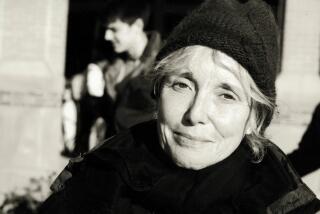PAGE TO SCREEN : Boyd’s ‘Good Man’
- Share via
This fall, fans of author William Boyd are finally getting to see his 1981 comic novel, “A Good Man in Africa,” on the big screen. The movie, released recently by Gramercy Pictures, stars Colin Friels, Sean Connery, Diana Rigg, John Lithgow, and Louis Gossett Jr. Directed by Bruce Beresford (“Driving Miss Daisy”) and scripted by Boyd, it jettison’s the book’s flashback narrative but retains most of its major plot points and characters, as well as some of its humor.
“Sixty to 70% of the average novel can’t get into a film,” says Boyd, who has adapted his own and others’ work to the screen before. “It’s all about editing, boiling down, looking for essence.”
Briefly stated, the story concerns a boozy, morally bankrupt British consular official in a tiny African state who gets involved with the boss’s daughter (and his wife), an unscrupulous local politician (and his wife), and a Scottish doctor of staggering rectitude. The doctor, Alex Murray, is the “good man” of the title, and the key to both the book and the movie. Boyd modeled him after his late father, a Scottish physician who had worked in Africa. Sometime after the book was published, but long before a movie was even being considered, Boyd and Connery met, and the actor immediately became fixed in Boyd’s mind as the perfect man to play Murray. Connery’s subsequent participation in the project, which Boyd and friend Bruce Beresford began as an “experiment” (they had previously worked together on “Mister Johnson”), in turn helped get the film made.
Connery also had a hand in shaping the character for the screen. Originally, Murray comes across as a rather dour, remote figure, but Connery, in consultation with Boyd, imbued him with his own wit, warmth and golf swing.
The other character whose edges were slightly sanded is the consular official, Morgan Leafy. In the book, he’s fat and freckled, with a receding hairline. But, as Boyd says, “you have to be ruthless about how your film is going to work,” and it was only going to work with someone more presentable. Beresford hit upon fellow Australian Colin Friels (“Class Action”), much to Boyd’s delight. “Colin Friels has a slightly bashed, slightly lived-in face, but he has that affable quality,” Boyd says. “Somebody you could sympathize with, but not exactly Tom Cruise.”
Boyd has no idea whether the book’s many fans will object to the changes, large and small. “It’s terribly unfair to judge a film by the book,” he says, “because the film will always come out second best.” In this case, because the filmmakers couldn’t quite find a visual equivalent to the book’s wonderful, corruscating language, he’s right.
More to Read
Only good movies
Get the Indie Focus newsletter, Mark Olsen's weekly guide to the world of cinema.
You may occasionally receive promotional content from the Los Angeles Times.









